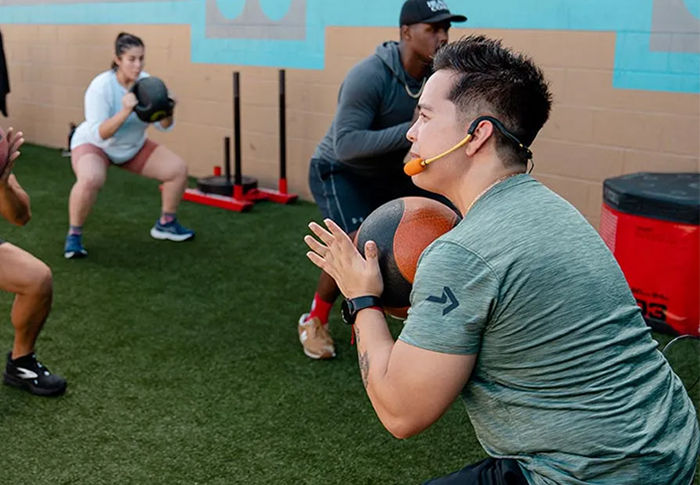|
Key Takeaways The question of whether women should focus on strength training at the expense of cardiorespiratory exercise as they age has been a trending topic on social media in recent weeks. What are the benefits of strength training for women? Is strength training more important than cardio? Should women replace the cardio they’re already doing with more strength training? This blog answers these and other key questions about women’s fitness and offers a balanced fitness routine for women. Read on for an evidence-based examination of this important element of women’s health throughout the lifespan. |
A common question when talking about fitness routines for women is whether it’s necessary to change the balance between cardiorespiratory exercise and strength training at different stages in life. Lately, social media has been full of advice telling women to shift their focus toward lifting weights, since resistance training has incredible benefits, especially as we age. But some women wonder: Will adding strength training compromise my endurance training? And on the flip side, if I love to lift, will adding cardio undo the progress I’ve made in my strength-training routine?
Both forms of movement are important, but depending on your goals, lifestyle and where you are in your health journey, you might benefit from shifting more attention toward resistance training than you have in the past. That said, this shift shouldn’t come at the expense of giving up cardio entirely, especially when aerobic movement supports your well-being or brings you joy.
General Guidelines for Strength and Cardio Training
The general exercise recommendations for adults include:
- Cardiorespiratory Training: At least 150 minutes of moderate-intensity or 75 minutes of vigorous-intensity aerobic activity, or an equivalent combination of the two, per week
- Resistance Training: Strength training for all major muscle groups at least two days per week
These recommendations apply broadly, but how you implement them might evolve over time, especially as your body and goals change.
Consider Adjusting the Focus Over Time
As women enter new life stages—whether returning to exercise postpartum or transitioning through menopause—resistance training can be especially important. For menopausal women, bone density naturally starts to decline, metabolism slows and hormone levels shift. For new mothers, core stability and energy levels may need targeted rebuilding. These bodily changes don’t require you to give up your favorite workouts, but they are a good reason to check in with how your training supports your long-term health and recovery.
While strength training is beneficial at every age, it plays an especially protective role when it comes to:
- Bone health: Strength training helps stimulate bone growth and can reduce the risk of osteoporosis.
- Muscle mass and metabolism: Lifting weights helps maintain muscle tissue, which supports a healthy metabolism.
- Hormonal health: Strength training can help regulate cortisol and support the natural decline in hormones like testosterone, human growth hormone (HGH) and insulin-like growth factor 1 (IGF-1). HGH and IGF-1 work together to support muscle repair, energy levels and recovery—key factors in maintaining lean body mass as we age.
- Cognitive and emotional health: Strength training stimulates the release of brain-derived neurotrophic factor (BDNF), which supports brain function, mood and focus.
- Functional independence: Lifting weights helps maintain the strength and balance needed to prevent falls and preserve mobility, which becomes more important with age.
For women in midlife and beyond, training at moderate to vigorous intensities [e.g., 60–80% of your one-repetition maximum (1-RM)] a couple of times a week—using movements that mimic daily life, such as squats, rows and presses—can be incredibly effective. And yes, you can safely lift heavy even after 50, especially when done with proper form and progressive programming.
Cardio Has Its Place, Too!
Strength training may deserve more emphasis than it has traditionally received, but that doesn’t mean cardio stops being important. Aerobic activity supports:
- Cardiovascular health: Cardio reduces the risk of heart disease and high blood pressure.
- Mood and brain health: Like strength work, cardio stimulates BDNF and helps improve focus, stress regulation and overall well-being.
- Stamina and fat metabolism: Cardio builds endurance and supports a healthy body composition.
If you’re someone who loves lifting but has hesitated to include cardio, know that adding even a couple of days of light to moderate aerobic activity (like walking, cycling, swimming or taking a short jog) can be part of a well-rounded recovery strategy that can improve performance and allow for higher training intensities and volumes, while reducing the risk of overtraining.
For many women, cardio provides a mental reset and a way to stay connected with others (like run clubs, for example). The goal isn’t to swap cardio for weights entirely—it’s to make sure both have a place in your week. A helpful guideline: Start with two full-body strength sessions, plus two or three sessions of cardio you genuinely enjoy.
Lastly, Don't Skip Recovery
Another important aspect of a balanced workout regimen to keep in mind is recovery. As we age, we tend to need a bit more of it. That means building in rest between strength sessions, prioritizing sleep and making time for mobility or flexibility work. It’s not about doing less. Instead, it’s about being smarter with how you train so you can keep doing it consistently.
What Might a Balanced Week Look Like?
Here’s one way to organize your training week if you're looking to include both strength and cardio, with two dedicated recovery days:
| Day | Focus |
| Monday | Strength training (lower body) |
| Tuesday | Moderate cardio (30–45 minutes of walking, jogging or cycling) |
| Wednesday | Mobility exercise or yoga (active recovery) |
| Thursday | Strength training (upper body or full body) |
| Friday | Light cardio or mobility exercise (e.g., walk, swim or stretch) |
| Saturday | Endurance session, strength training, or a fun recreational activity—based on your training goals and program |
| Sunday | Full rest |
This schedule provides a flexible balance of strength, cardio and recovery, and can be adjusted to match your fitness level, preferences and time availability. It also allows for muscle recovery, cardio variety and flexibility.
In Summary
Whether you’re just getting into exercise or have been training for years, it’s worth revisiting your routine every so often. Strength training offers big returns for bone health, metabolism and functional movement, and becomes even more essential as we get older. But cardio is still part of the equation, especially when it’s something you love that keeps you moving. Aim for balance, listen to your body and don’t be afraid to shift your focus based on what feels right for your health now.
| If you’re interested in learning more about coaching and training strategies specific to your female clients, check out these continuing education options: |
 |
Strategies for Training Female Clients—Course Bundle (worth 0.4 ACE CECs): This bundle includes three courses that provide a holistic approach to improving your female clients’ fitness regimen and overall health: Weightlifting for Women, Training Female Clients Through Different Life Stages, and Training Women for Optimal Health and Performance. |
 |
Coaching and Training Women (worth 0.5 ACE CECs): Led by five industry experts, this course will help you become a leader in supporting women on their fitness journeys. This course is focused on providing practical knowledge that you can use to level up your skillset and better serve your female clients. |




 by
by 









 by
by